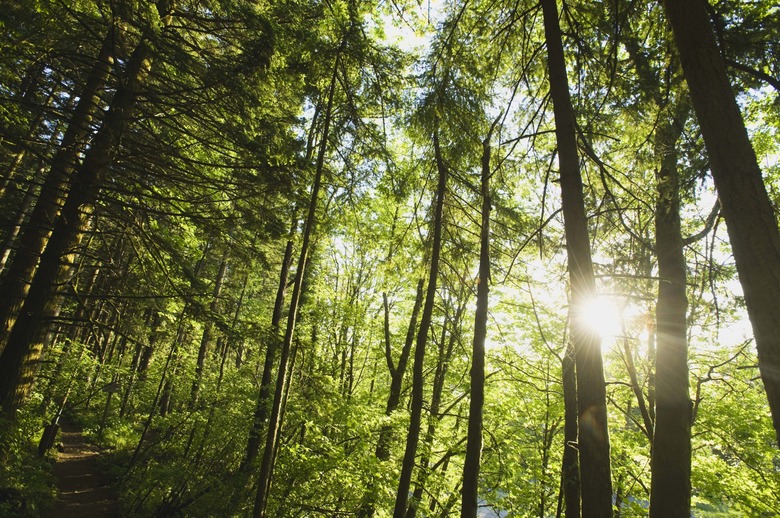The Parts Of Trees And Their Functions
All trees share these three basic parts, no matter what type of tree you're examining. From palm trees with their expansive, shallow fibrous root system to giant redwoods hundreds of feet tall, every tree has the same three elements: the root system, a trunk and a crown. Most trees begin with a taproot system and develop a fibrous root system as they grow. There are also wide variations in the type of leaves, from simple to scale-like to needles. Within each of the three parts there are variations, but these three essential elements exist no matter what size the tree is or which climate it resides in.
Roots
Roots
A tree's root system pulls nutrients and water from the soil and carries it to the trunk for distribution through the tree. A tree that grows tall and thick like a redwood needs a root system that grows thick and deep to anchor it. Trees that grow in desert climates tend to have long, tendril-like roots that stay near the surface of the soil to catch rain more easily. Roots tend to grow to the size and depth needed to adapt to water levels in the soil. When a seedling forms a taproot grows straight down and sub-roots grow off it. As the tree develops a number of central taproots grow and the root system becomes a fibrous root system with many branches supporting and feeding the tree.
Trunk
Trunk
Once the water and minerals pass through the roots and reach the trunk, they're carried up through the outer layers of the tree just below the bark. The trunk doesn't just transport water and minerals up from the ground, it also carries sugars from the leaves down to the roots to support and feed the root system. The trunk is the central support system for everything that happens in the tree. It's also the part of the tree that's harvested for lumber and to make paper.
The four layers
The four layers
Within the trunk there are four layers. Starting from the center there's heartwood, xylem, cambium and phloem. The heartwood is a hard core of old xylem layers that have died and become compressed by the newer outer layers. The xylem is also called sapwood and carries water and minerals up the trunk. The cambium is a thin layer where new cells develop to either become xylem, phloem or more cambium. A cambium layer is turned into xylem once per year and this creates an annual ring around the trunk. Just outside the cambium, the phloem transports sugars from the leaves down to the roots and as it dies it forms the bark.
Crown
Crown
Above the trunk is the crown. The crown is all the branches and leaves on the tree. The crown is the powerhouse of the tree. The leaves take in sunlight which reacts with the green chlorophyll to transform light into sugars. The process is called photosynthesis and the byproduct is oxygen released into the air. Photosynthesis occurs whether the leaves are broad and flat like a simple leaf or thin and pointed like needles. Leaves vary widely, but they all perform photosynthesis to feed the tree. Not only does the crown produce the sugars the tree needs to survive, it also filters dust from the air and protects the soil below from excessive erosion from rainfall.
References
Cite This Article
MLA
Kerr, Jocelyn. "The Parts Of Trees And Their Functions" sciencing.com, https://www.sciencing.com/the-parts-of-trees-and-their-functions-12620561/. 14 November 2018.
APA
Kerr, Jocelyn. (2018, November 14). The Parts Of Trees And Their Functions. sciencing.com. Retrieved from https://www.sciencing.com/the-parts-of-trees-and-their-functions-12620561/
Chicago
Kerr, Jocelyn. The Parts Of Trees And Their Functions last modified March 24, 2022. https://www.sciencing.com/the-parts-of-trees-and-their-functions-12620561/
